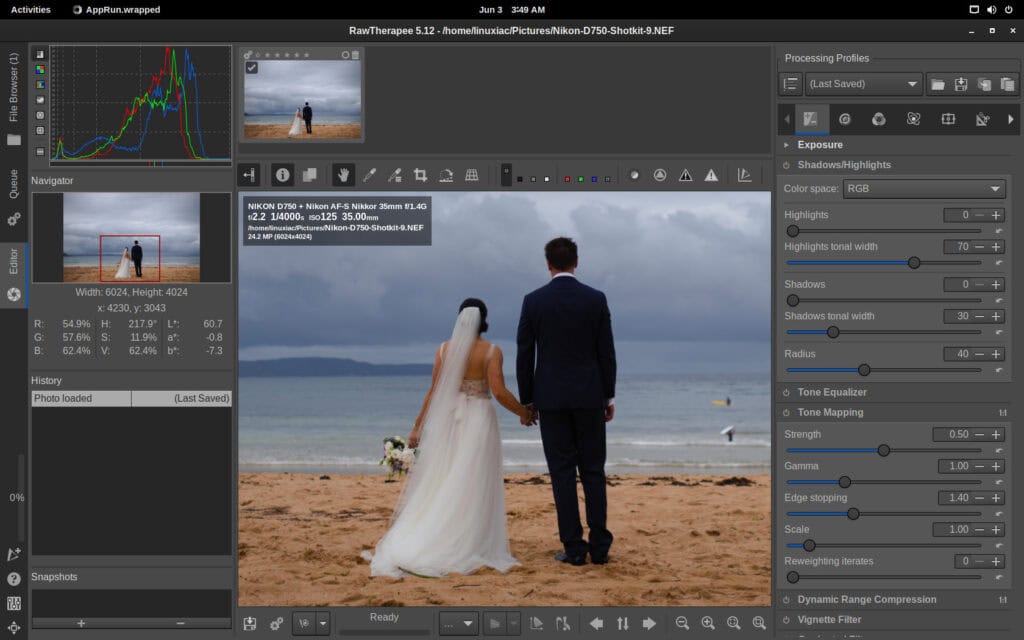Eight months after its previous 5.11 release, RawTherapee, a powerful cross-platform open-source photo editing software designed for processing raw files and producing high-quality image outputs, has just been updated to version 5.12.
One of the standout additions in this release is the Dehaze option within the Raw Black Points tool. This feature effectively sets black points to the image’s minimum values, often reducing atmospheric haze and clarifying details that might otherwise be washed out. Consequently, images shot in foggy or backlit conditions can benefit from enhanced contrast and richness.
Moreover, this capability is particularly useful for landscape photographers who frequently contend with hazy skies or misty conditions; by pulling more definitive blacks from the shadows, the overall tonal separation improves, yielding more punchy, detailed images.
Moreover, those working with wide-angle lenses will appreciate the newly integrated de-fish feature under Distortion Correction. Previously, fisheye images required external tools to achieve a rectilinear look, but now RawTherapee itself can convert equidistant fisheye projections into normal perspective images.
This means you can correct dramatic curving edges—especially in architectural or action sports shots—without leaving the RawTherapee environment. Furthermore, for cases where the automatic fill doesn’t quite satisfy your needs, a Scale adjuster allows manual tweaking of the transformed image, granting precise control over how the corrected frame is resized and cropped.
Another noteworthy enhancement addresses users of Canon cameras: all images in a Canon RAW burst mode file are now accessible. Previously, RawTherapee could only load the first six shots from a burst; now, every image in that sequence is at your fingertips.
Regarding color science, RawTherapee 5.12 introduces a new Gamut Compression tool. Built on the ACES (Academy Color Encoding System) Reference Gamut Compression operator, this feature is designed to tame highly saturated colors and fit them within a user-selectable gamut before other color adjustments occur.

In simpler terms, if you’ve ever encountered clipping or oversaturated patches—common when shooting under intense studio lights or with vivid sunsets—the Gamut Compression tool helps bring those colors back into a natural range.
For those who like to add a polished finishing touch directly within RawTherapee, the Resize tool has been reborn as Resize & Framing. In addition to the usual scaling capabilities, you can now add a decorative solid-color border to your images before saving them.
On the technical side, RawTherapee 5.12 adds support for demosaiced floating-point DNGs, which means that advanced users working with high-dynamic-range or HDR workflows can import and process these files seamlessly. Similarly, the Abstract Profile tool gains a Contrast Enhancement option.
Color grading aficionados will also notice that the Color Appearance tool in Selective Editing now incorporates several enhancements under the banner of Tone Mapping Operators (formerly Highlight Attenuation & Levels). Notably, the RGB channel Slope tone mapper (formerly Levels) offers new settings to fine-tune tonal roll-off, while a brand-new Sigmoid-based tone mapper provides an alternative local tone-mapping curve that can yield smoother, film-like renditions.
Lens correction hasn’t been overlooked either: more Sony lenses are now recognized, improving the accuracy of quick info overlays and enabling automatic profiled lens correction for a broader range of gears.
Regarding camera and raw format support, version 5.12 continues RawTherapee’s tradition of staying up to date. Among the newly added or improved profiles, you’ll find:
- Canon EOS R8 (including DCP profiles and correct black-level handling in electronic shutter mode)
- Fujifilm X-E4 (proper raw crop support in electronic shutter mode)
- Sony ILCE-7CR (pixel-shift functionality)
- Sony ILCE-7M3 (correct black-level processing)
- Sony ILME-FX3 (accurate black level when not using LibRaw)
A major under-the-hood shift in this release is the adoption of LibRaw as the default raw file reading library. Historically, RawTherapee relied on an enhanced fork of dcraw, which, despite its reliability, hadn’t seen updates in nearly seven years.
Starting with version 5.11, RawTherapee can optionally leverage LibRaw to read raw files; in 5.12, this integration is solidified. When LibRaw encounters an unfamiliar raw file, RawTherapee gracefully falls back to the enhanced dcraw.
Lastly, keep in mind, however, that the enhanced dcraw cannot read certain raw formats that LibRaw can; therefore, disabling LibRaw in your preferences might actually limit support for newer camera models. Finally, be aware that LibRaw support will become mandatory in a future RawTherapee release, so reporting any hiccups now helps both you and the community down the line.
Refer to the release announcement for detailed information (and downloads) about all changes in RawTherapee 5.12.
